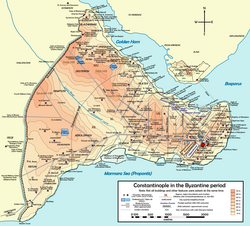
Constantinople (part of modern Istanbul, Turkey) was built on the land that links Europe to Asia through Bosporus and connects the Sea of Marmara and the Black Sea. As a transcontinental city within the Silk Road, Constantinople had a strategic value for many empires and kingdoms who tried to conquer it throughout history.
Contents
Known as Byzantium in classical antiquity, the first recorded siege of the city occurred in 510 BC by the Achaemenid Empire under the command of Otanes. Following this successful siege, the city fell under the rule of Persians until it won its independence again, and around 70 BC it became part of the Roman Republic, which was succeeded by the Roman Empire. Despite being part of Rome, it was a free city until it came under siege by Septimius Severus between 193–196 and was partially sacked during the civil war. After it was captured by Constantine the Great in 324, it became the capital of the Roman Empire, under the name of New Rome. It later became known as Constantinople, and in the years that followed it came under attack by both Byzantine pretenders fighting for the throne and also by foreign powers for a total of 22 times. The city remained under Byzantine rule until the Ottoman Empire took over as a result of the siege in 1453, known as the Fall of Constantinople, after which no other sieges took place.
Constantinople was besieged 36 times throughout its history. Out of the ten sieges that occurred during its time as a city-state and while it was under Roman rule, six were successful, three were repelled and one was lifted as a result of the agreement between the parties. Three of these sieges were carried out by the Romans who claimed the throne during civil war. Of all the sieges that took place from its founding by Constantine the Great till 1453, only three were successful, 21 were unsuccessful, and three were lifted by reaching mutual agreements. Four of these sieges took place during civil wars. The Sack of Constantinople that took place in 1204 during the Fourth Crusade caused the city to fall and to be established as the capital of the Latin Empire. It also sent the Byzantine imperial dynasty to exile, who founded the Empire of Nicaea. Constantinople came under Byzantine rule again in 1261 who ruled for nearly two centuries. The city was taken by the Ottomans with the siege in 1453, and as a result the Byzantine Empire came to an end. The city has been under the rule of Turks since the last siege, except for the period of Allied occupation from 1920 to 1923.